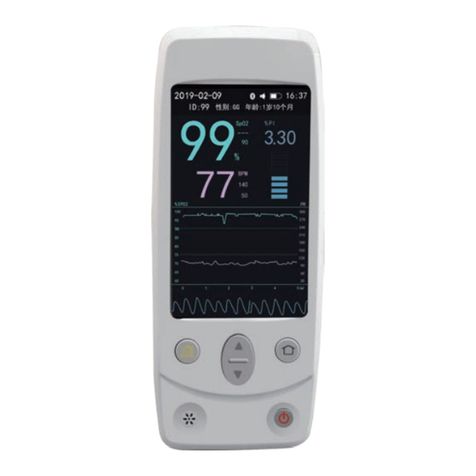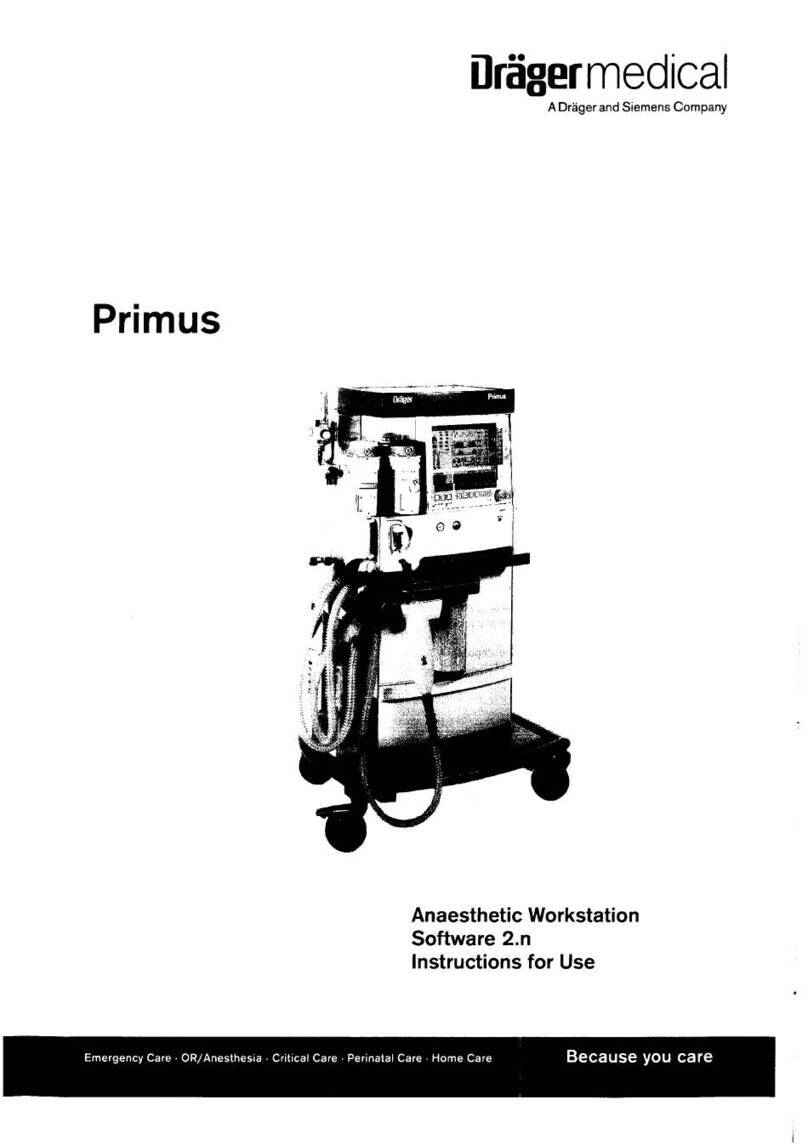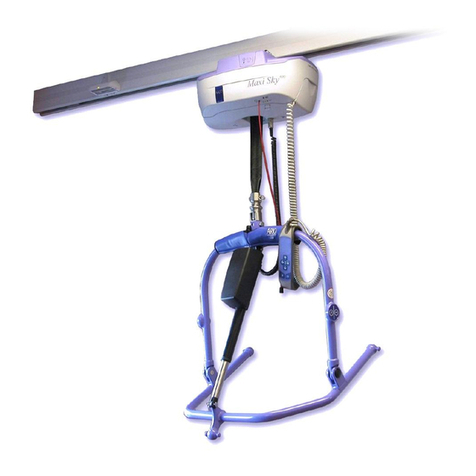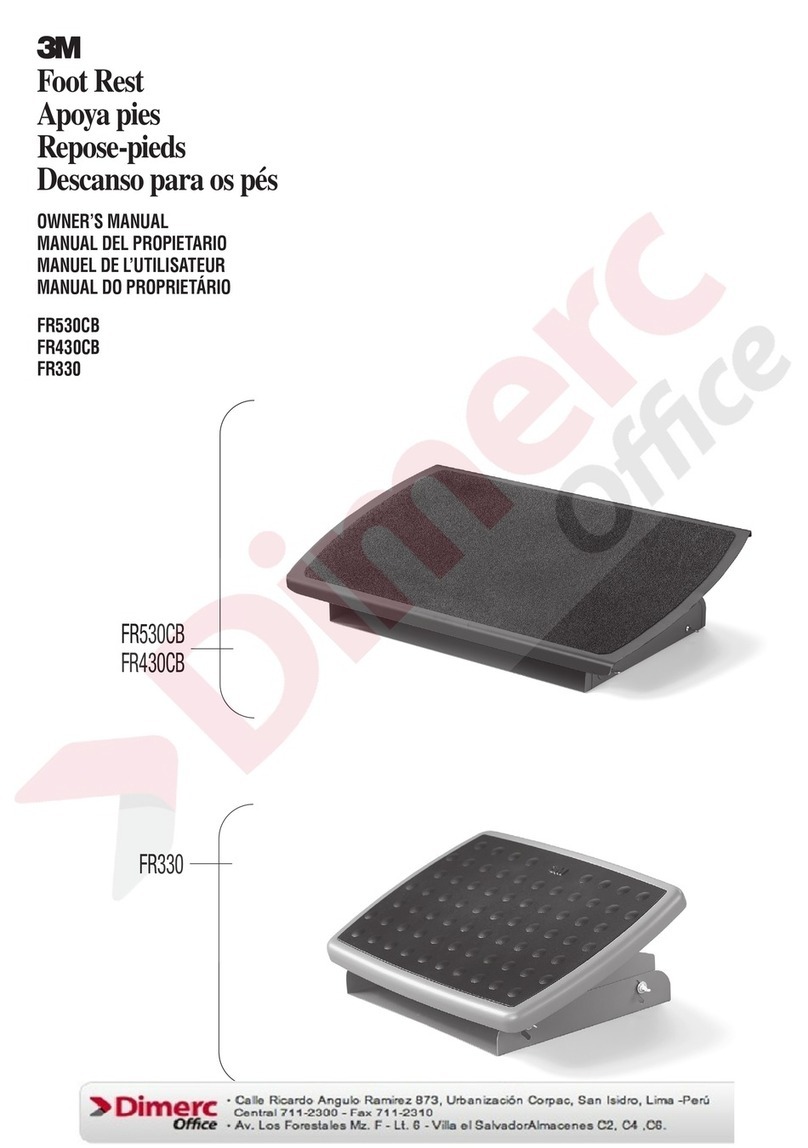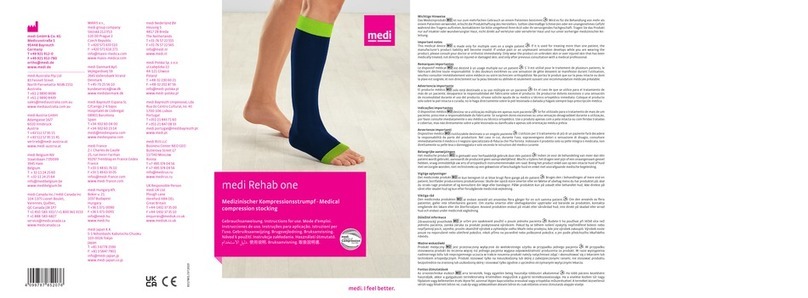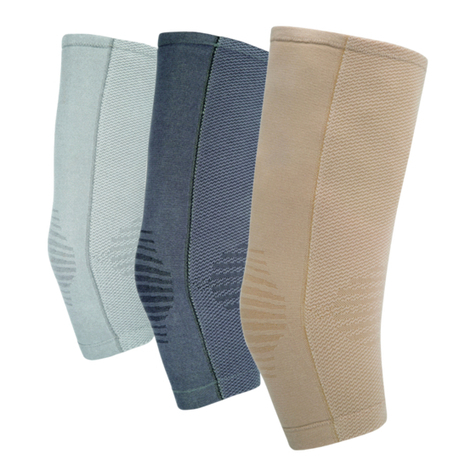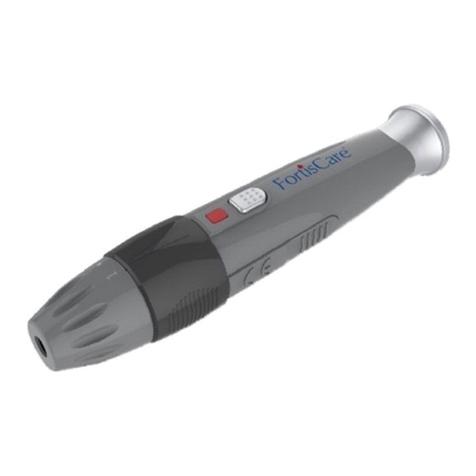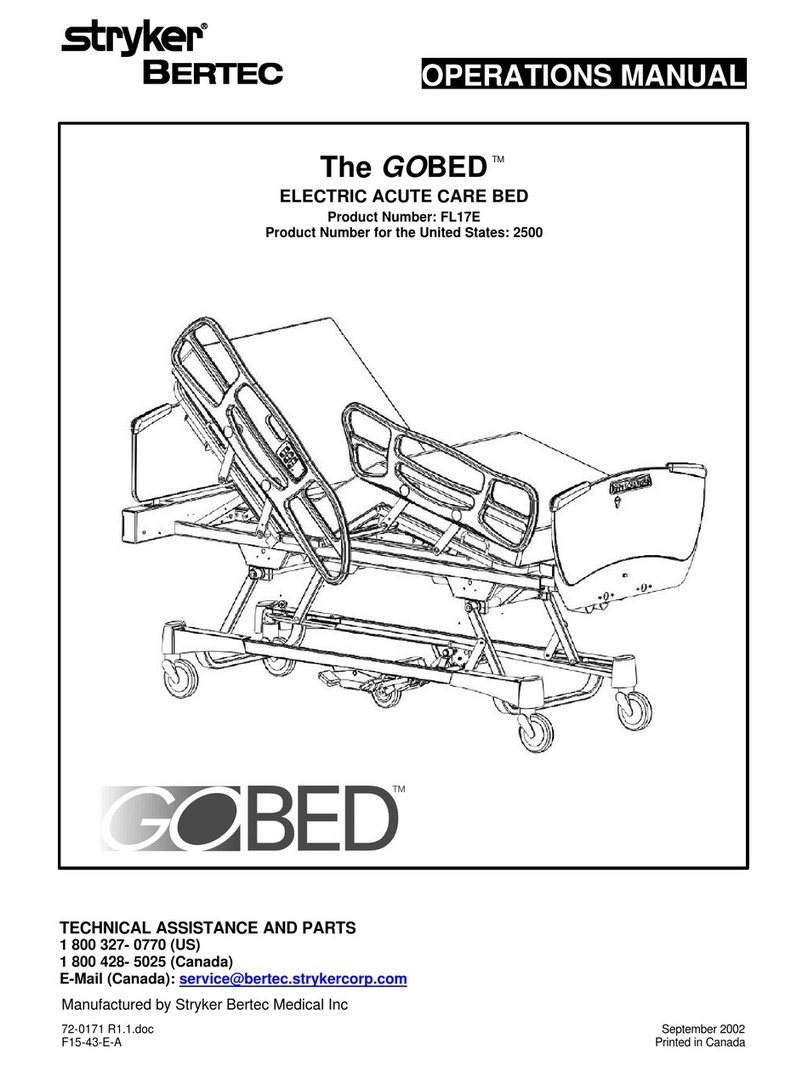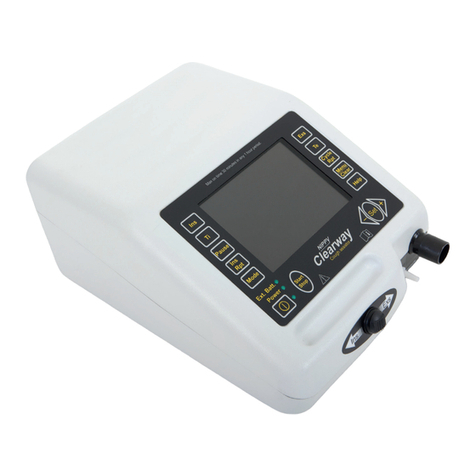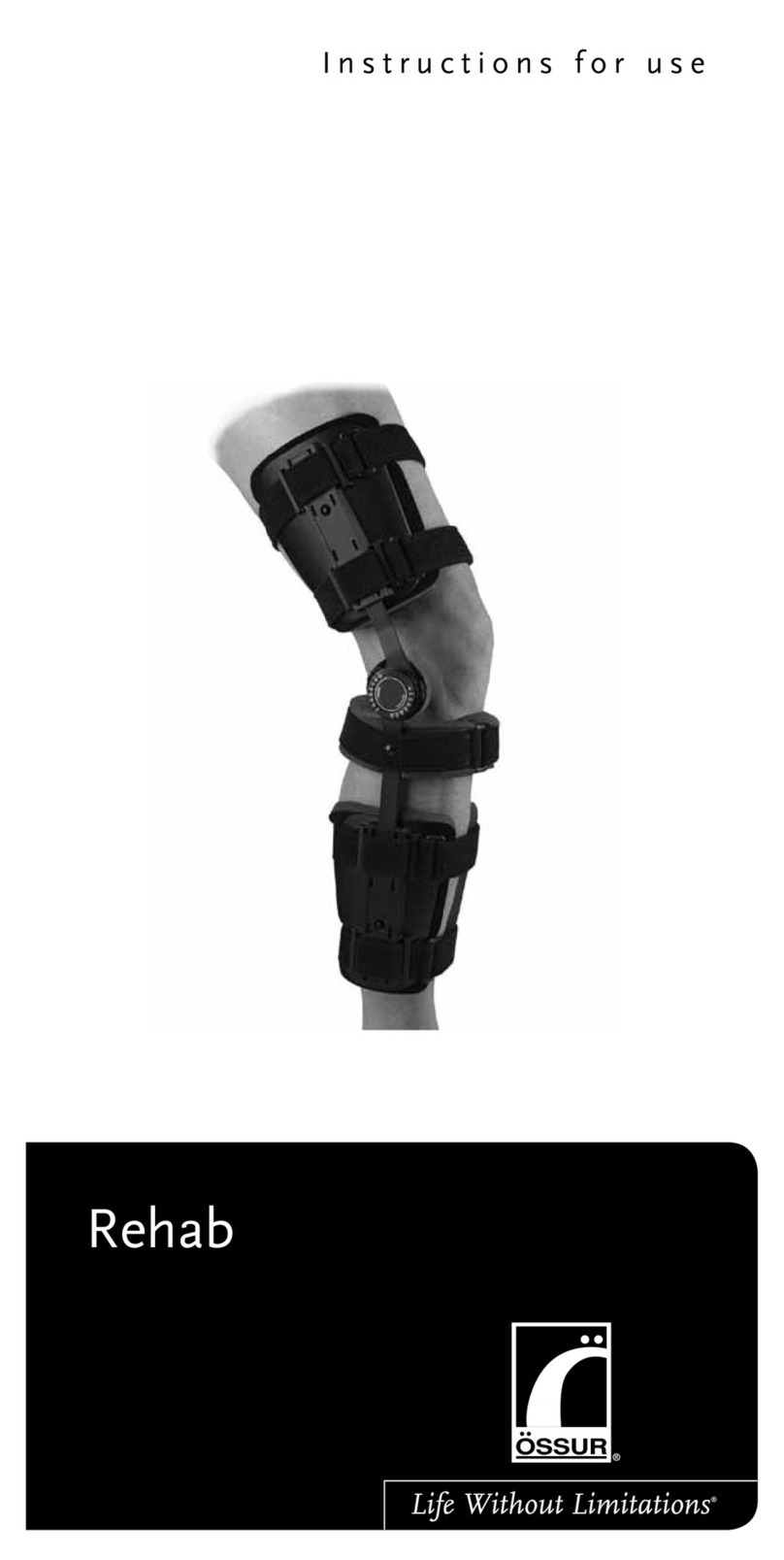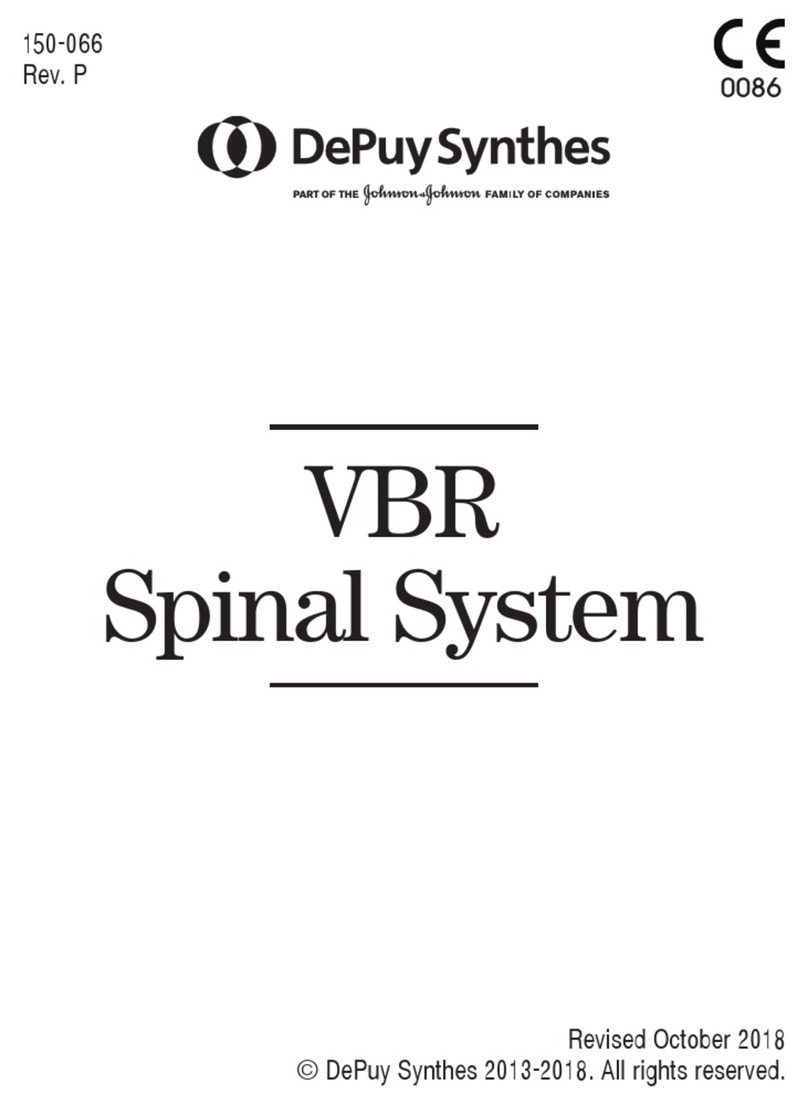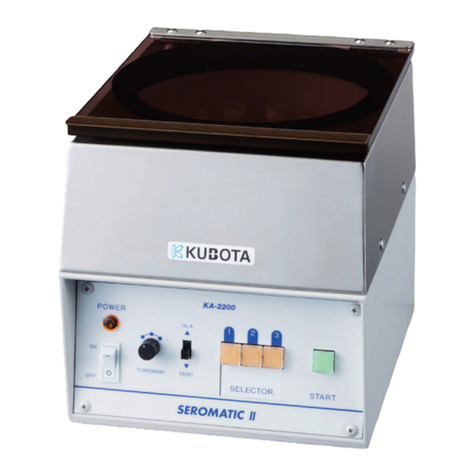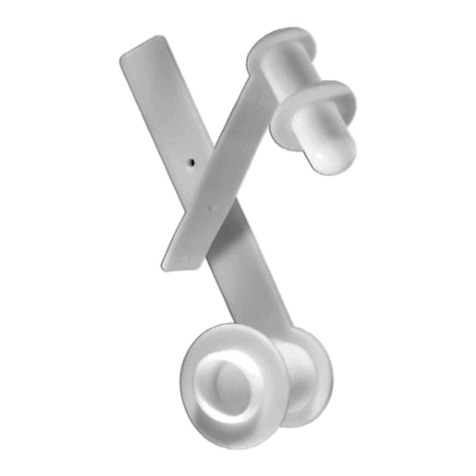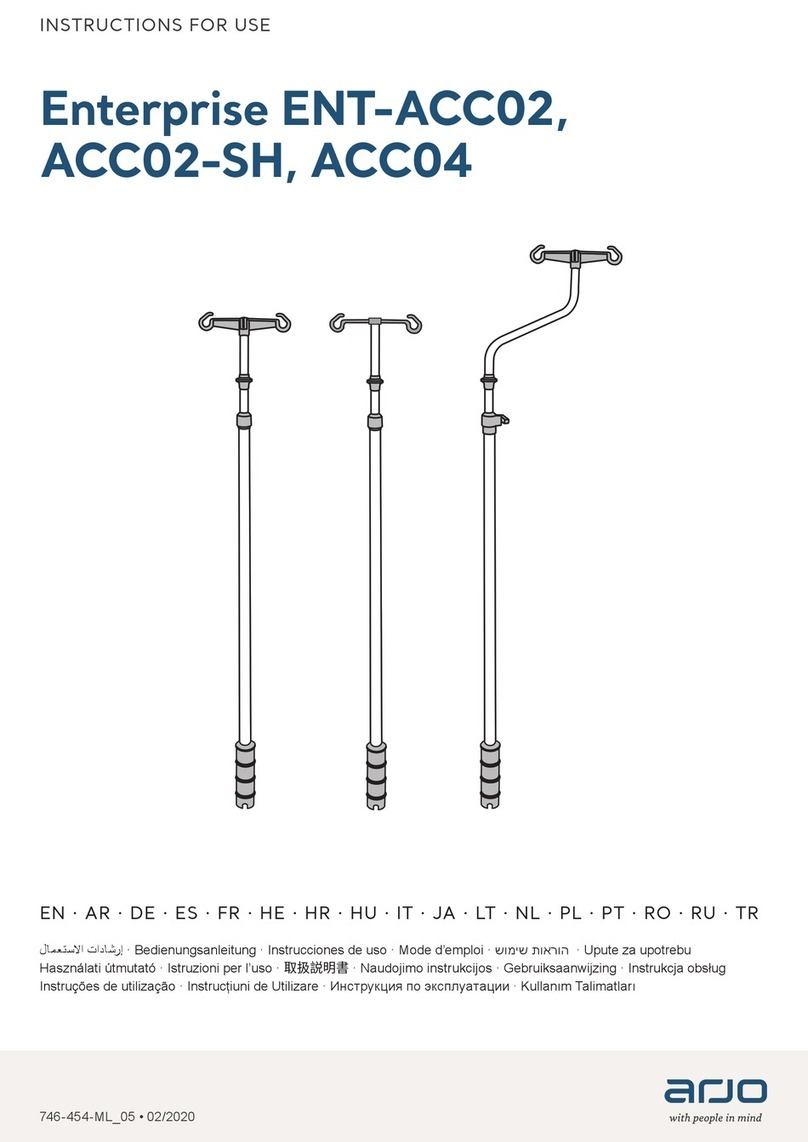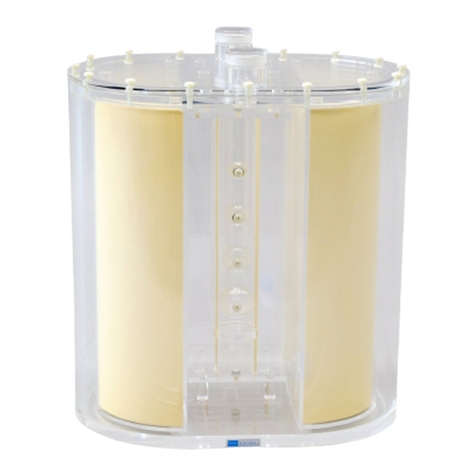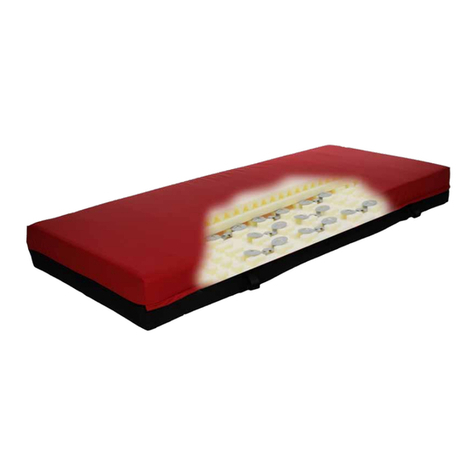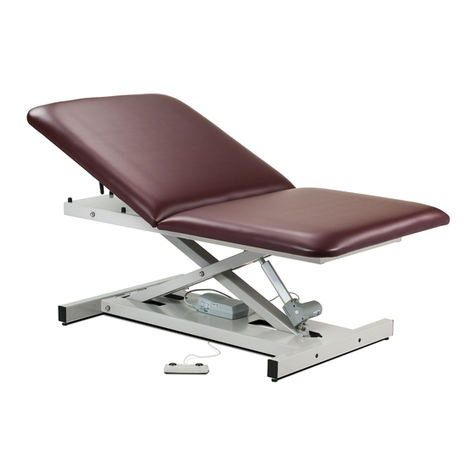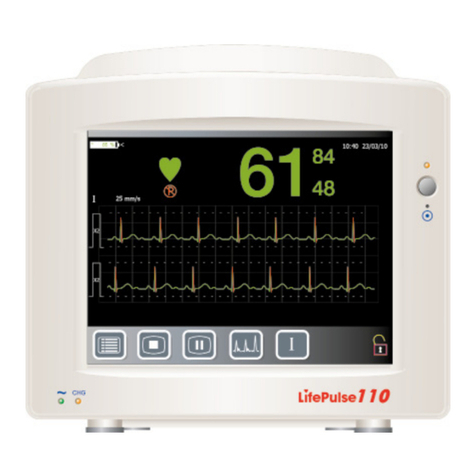Med-link Electronics AM-806VB User manual

Address: 4th and 5th Floor, Building Two, Hualian Industrial
Zone, Xinshi Community, Dalang Street, Longhua District,
518109 Shenzhen, CHINA
Fax: +86 755-61120055 Email: [email protected]
Website: www.medxing.com
Shenzhen Med-link Electronics Tech Co,.Ltd
AM-806VB REV A.1
Revision date: October 24, 2019
Veterinary Temp-pulse Oximeter
Instructions for use
AM-806VB
Please read user manual carefully before operate
*Product picture is for reference only, please refer to the object

The Veterinary Temp-pulse Oximeter manual is intended to provide information for
proper operation and maintenance. General knowledge of monitoring and
understanding of the features and functions of the Veterinary Temp-pulse Oximeter
are prerequisites for proper use. Please read the instructions for use carefully before
using this device.
Please operate the device in strict accordance with the operation procedures
described in the instructions for use. Failure to follow these instructions may cause
improper measurement, equipment damage, injury of animal subject and so on. The
manufacturer is NOT responsible for the insecurity, performance instability, injury of
animals, device damage, etc. due to user’s negligence of the instructions for use.
The Veterinary Temp-pulse Oximeter is a medical device, and can be used
repeatedly.
Warning
Foreword !
Explosion hazard. Do not use the Veterinary Temp-pulse Oximeter in the
presence of flammable anesthetics or gases.
The device is limited to be used by one animal at the same time.
Do not spray, pour, or spill any liquid on the Veterinary Temp-pulse Oximeter
together with its accessories, connectors and switches.
Repeated use of the sensor must be applied on a new position every 4 hours
during the test. Because animal subject’s skin condition affects the ability of the
skin to tolerate sensor placement, it may be necessary to change the sensor site
more frequently concerning some animals. If skin integrity changes due to the
placement of the sensor, move the sensor to another site.
With the increasing of the ambient temperature, skin of animal subject may be
severely burned after prolonged sensor application at sites that are not well
perfused. To prevent this situation, please check application sites of animal
subject frequently. If the initial skin temperature does not exceed 35 ° C, the
operation of the sensor will not cause the skin temperature to exceed 41 ° C.
Inaccurate respiration rate(RR) measurements may be caused by improper
placement or alignment,low arterial perfusion,excessive motion and cardiac
arrhythmias.
After the sensor is removed from the animal subject, data and waveform may still
be displayed on the oximeter due to external light interference. This does not
mean that the probe malfunctions, but the value displayed at this time cannot be
used as a basis for clinical diagnosis.
Portable electrical equipment and mobile RF communication equipment may
affect the usage of the product.
Veterinary Temp-pulse Oximeter must not be disposed as unsorted normal waste
but be classified and managed. Please contact an authorized representative of
the manufacturer for correct information concerning the disposal of the product.
Please refer to the related literature about the clinical restrictions and
precautions.
This device is not intended for treatment.
The LCD panel contains toxic chemicals. Please do not put the damaged LCD
panel in the mouth or swallow it.
Do not modify this device without authorization of the manufacturer.
Latex Content Statement
All parts of the Veterinary Temp-pulse Oximeter and accessories that are in contact
with the animal subject are free of latex.
About This Manual
This manual is provided for the operator or the user to read carefully after which
they can use the oximeter correctly.
Product model: AM-806VB
Product name: Veterinary Temp-pulse Oximeter
Trade name: Pulse Oximeter
Registration / production address: 4th Floor, Building A, Ying Tailong Ind Park,
Dalang South Road, Longhua District, Shenzhen
Product information

Table of contents
>>>
Chapter 1-Overview …………………………………………01
1.1 Intended use ……………………………………………01
1.2 About this temperature and pulse oximeter ………………01
1.3 Panel Buttons and Symbol Description …………………01
1.4 Technical Specifications …… ………………………02
1.5 Warning … …………… ………………………03
1.6 Symbols and signs …………… ……………………04
1.7 Product structure …………… ……………………05
1.8 Measuring principle …………… ……………………06
1.9 Clinical taboos ……………… ………………………06
1.10 Attention ………………… ………………………07
1.11 Unpacking inspection ……… ………………………07
1.12 Packaging ………………… ………………………07
Chapter II-Operation ……………………………………08
2.1 Installation and confirmation ……… ……………………08
2.2 Operation and use …………………………………10
2.3 Security ……… …………………………………11
……
………
……… ………
………
………
………
………
………
………
………
……
…
………
…… ………
2.4 Function settings ……………………………………………12
2.5 Menu Settings ………………………………………………13
2.6 List of applicable accessories ……………………………16
Chapter III-Abnormal Situations and Troubleshooting …17
Chapter IV-After-sales service and maintenance ………19
4.1 Cleaning and disinfection ………………………………19
4.2 Calibration …………………………………………………19
4.3 Repair and maintenance ………………………………19
4.4 Warning ……………………………………………………20
4.5 Warranty …………………………………………………20
Chapter 5-Names and Contents of Toxic and Hazardous
Substances or Elements in Products ………21………………

1
Section 1- Overview
1.1 Intended Use
The Veterinary Temp-pulse Oximeter is intended for non-invasive detection and
measurement of arterial oxygen saturation(SpO2), pulse rate respiration rate and
temperature of animal.
1.2 About the Veterinary Temp-pulse Oximeter
The device contains a dual light source (red LED and infrared LED) and a photo
detector. Bone, tissue, pigmentation and venous vessels normally absorb a constant
amount of light over time. The arteriolar wall normally pulsates and absorbs variable
amounts of light during the pulsations. Functional oxygen saturation (SpO2) can be
calculated from the ratio of absorbed light. Since the measurement of SpO2 depends
on light source from the device, a strong light source in the surrounding environment
will affect the measurement accuracy.
If the animal temperature is measured, an external temperature probe specified by
Medlinket must be connected to the host. Refer to Table 2 for details.
1.3 Identification of Panel and Symbols
A complete description of all buttons, symbols, controls, displays and indicators.
,
Figure 1: Front Panel and Left Panel of Veterinary Temp-pulse Oximeter
1— Menu button/Power button 6— Waveform Display
2— %SpO2 Display 7— Bar graph (The Pulse Amplitude Indicator)
3— Battery indicator 8— Display direction switch
4— Temperature Display 9— Accessory connector
5— Pulse Rate Display (bpm)
1.4 Technical Specifications
Battery
Temperature Note: This temperature measurement function can only be achieved with a connection to our
company’s temperature probe. See Table 2 in this instructions for use for details.
Operating Current
Pulse and oxygen saturation
SpO2 Measurement Accuracy
SpO2 Resolution
Reminder
90% to 100% range: ±2%;
70% to 89% range: ±3%
<70%: unspecified
Low-battery indicator. When the battery is low,
the device will be turned off after the voice of
“beep-beep”
1%
Method
Pulse Rate Resolution
Optical output power
Pulse Rate Measurement Accuracy
Pulse Rate Measurement Range
LED Wavelength
Updating time
Average data time
Dual wavelength LED transmitting tube
1 bpm
Red: approximately 660nm;
Infrared: approximately 905nm
1 sec
30 to 300bpm
±3 bpm
Less than 15mW
8 sec
SpO2 Measurement Range 35% to 100%
Less than 55mA
Only Temp function works Less than 40mA
SpO2 and Temp function
work together Less than 60mA
Only SpO2 function works
Measurement Range & Accuracy
Temperature Resolution
77°to 113°F (25℃ to 45℃): ±0.2℃
±0.1℃
Battery specification 3.7V Rechargeable lithium battery
2
4
1 2 35 8
6
7
9
Respiration Rate(RR) Measurement Range
Respiration Resolution
Respiration Measurement Accuracy
6rpm-70rpm
1 rpm
±2 rpm

方法
34
Bluetooth
Dimension and Weighting
Operating Temperature
Atmospheric pressure
for transportation and storage
41°F~104°F (5℃~40℃)
86kPa~106kPa
Protection Against Liquids
Weight
Size
IPX2, Vertically falling drops shall have no harmful effects when
the enclosure is tilted at any angle up to 15°on either side of the
vertical; IPX1, Vertically falling drops shall have no harmful effects
80.0*38.0*40.0mm
60g
Transmitting frequency
Modulation Type
2.4G
GFSK
Environment
Transportation and
Storage Temperature 14°F~104°F (-10℃~40℃)
Transportation and
Storage Humidity 0%~80% No condensation
Classification
Frequency characteristic
Radiation power
FHSS
0dbm
This device is calibrated to show functional oxygen saturation.
The displayed value of this device is averaged, and there is a certain delay relative to the real data.
The pulse wave displayed on the device is normalized.
The pulse amplitude intensity represents the relative intensity of the tester's arterial pulsation, and a
weak pulse amplitude intensity value can cause erroneous readings.
To ensure the accuracy of temperature measurement, please use the reusable body cavity
temperature probe for animal to measure the same position for at least 90 seconds.
Medical high frequency signals or defibrillator interference can cause erroneous readings.
External ambient light interference will affect the accuracy of blood oxygen.
The movement interference of the animal subject will affect measurement accuracy.
This product does not have an alarm function, but it provides a settable prompt function when the
value is beyond the range. Please pay attention to the related information.
1.5 Warnings !
1.6 Symbols and signs
SpO2, Pulse Rate, Temperature, Pulse Waveform, Bar Graph and Low-Battery Indicator
Display Parameters
NON
STERILE
-10℃
40℃
80%
0%
Warning
Non-sterile Packaging
Refer to instructions
for use
DO NOT THROW
AWAY Intended for
multiple use
Temperature limits
for transportation
and storage
Humidity limit for
transportation and
storage
Atmospheric pressure
for transportation
and storage
Electronic products
Environment-friendly
use period
Date of manufacture
Batch Code
Protected against
vertically falling water
drops when enclosure
tilted up to 15°
Compliance with
WEEE Standard
No SpO2 Alarm
CE Mark: conforms to essential requirements of the Medical Device
Directive 93/42/EEC. 0123 is Notified Body Number
LOT

56
1.7 Product parts and accessories
The Veterinary Temp-pulse Oximeter is composed of host, USB cable, tongue-clip
SpO2 probe and reusable body cavity temperature probe for animal. The host is
composed of display screen, control buttons and so on. The accessories include
SpO2 probe, reusable body cavity temperature probe for animal and USB cable.
1.7.2 Accessories
The measurement of pulse oximetry is achieved by calculating the change in the
absorption rate of transmitted light during capillary pulsation of animal limbs, tongue,
and earlobe, etc., which is a continuous, non-invasive measurement method of
hemoglobin oxygen saturation ( Functional saturation). Since oxyhemoglobin and
deoxyhemoglobin show different absorption rates for two specially selected incident
lights with different wavelengths, different oxyhemoglobin saturation can be
determined, ie, FO2Hb.
The company's Veterinary Temp-pulse Oximeter uses two transmitted light sources
with different wavelengths, namely about 660 nm for red light and about 905 nm for
infrared light. One side of the sensor contains two LEDs, and the other side contains
a photoelectric detector. The two luminous tubes emit lights alternately. The light is
weak when the pulsation is measured by the photoelectric sensor, and the light is
stronger between two pulsations, thus the reduced value is the light intensity
absorbed by the pulsatile arterial blood. In this way, the light absorption ratio of the
two wavelengths can be calculated, thereby the oxygen saturation of the arterial blood
can be accurately measured within the range of 70%~100%, obtaining the "pleth"
waveform and the pulse rate value.
1.8 Principle of Measurement
Fractional saturation FO2Hb= X100
O2Hb
RHb+O2Hb+MetHb+COHb
Functional oxygen saturation= X100
O2Hb
RHb+O2Hb
1) As the measurement is taken based on the pulsation of the arteriole, the tester's
blood should ensure a steady flow. For an animal subject with weak perfusion due to
shock, low ambient/body temperature, massive haemorrhage, or use of vascular-
contracting drug, the SpO2 waveform will decrease. In this case, the measurement
will be more sensitive to interference.
2) For those drugs with a substantial amount of staining dilution such as blue, indigo,
green, and acidic indigo methylene, carbon monoxide hemoglobin, methionine,
thiosalicylic hemoglobin and some icterus problems, the usage of the device for
measurement of SpO2 may be inaccurate.
3) Drugs like dopamine, procaine, prilocaine, lidocaine and butacaine may also be a
major factor blamed for serious error of SpO2 measurement.
4) The SpO2 value serves only as a reference value for judgement of anemic anoxia
and toxic anoxia in related animals. It can also be used as a measurement of pulse
oximetry for severe anaemic animals.
1.9 Clinical Restrictions
1.7.1 Host
Figure 2 Structure of host
Control
button
Display
Screen
Cable
Probe
Connector
Connector
Probe
Cable
Device connector
cable
Pulse oximetry
probe & Temperature
probe connector
Figure5 USB Cable
Figure3
Tongue-clip SpO2 probe for animal
Figure4
reusable body cavity temperature
probe for animal

78
1.10 Attentions
Keep the oximeter away from dust, vibration, corrosive substances, explosive mate-
rials, high temperature and moisture.
If the oximeter gets wet, please stop using.
When it is carried from a cold environment to a warm and humid environment, please
do not use it immediately.
DO NOT operate keys on front panel with sharp materials.
High temperature or high pressure steam disinfection of the oximeter is not permitted.
Refer to instructions for use for instructions of cleaning and disinfection.
Do not immerse the oximeter in liquid. When it needs cleaning, please wipe its surface
with soft cloth with disinfectant. Do not spray any liquid on the device directly.
When cleaning the device with water, the temperature should be less than 60℃.
The probe is designed for use with a specific monitor. It is the responsibility of the
operator to check the compatibility of the monitor, probe and extension cable
before use. Incompatible accessories can cause performance degradation of the
device.
Remove the Veterinary Temp-pulse Oximeter from the box and check the shipping
label for damage, then check whether all parts are complete or not according to the
packing list. Save the invoice, bill of lading and all packing materials. These may be
required if it is necessary to process a claim with the carrier.
If anything is missing or damaged, please contact the Technical Service Department.
You can contact by:
Phone: +86 755 61120085
Fax: +86 755 61120055
Email: [email protected]
1.11 Unpacking and Inspection
1.12 Included in the package
Section 2- Operation
Insert the probe into the adapter attachment port, as shown in Figure 6.
Insert the USB cable into the adapter attachment port, and the host can be
connected to the standard usb port through the cable for charging.
2.1 Installation and Verification
Do not use the Veterinary Temp-pulse Oximeter in the presence of flammable and explosive
anesthetic gases, oxygen, nitrous oxide, etc.To ensure accurate performance and prevent
device failure, do not operate the Veterinary Temp-pulse Oximeter in places that are
extremely humid.
Performance Tests
Turn on the Veterinary Temp-pulse Oximeter power to prepare for the
measurement of animal subject.
Power-On & Self-Test
Before using the Veterinary Temp-pulse Oximeter, you must verify that the
product is working properly and is safe to use. Proper working conditions should
be verified each time when the Veterinary Temp-pulse Oximeter is turned on as
described in the following procedure. The verification procedure (POST) takes 2
to 3 seconds to complete.
2.1.1 Accessory installation
2.1.2 Performance Verification
Veterinary Temp-pulse Oximeter (host)
Instructions for use of Veterinary Temp-pulse Oximeter
Tongue-clip SpO2 probe for animals
Reusable body cavity temperature probe for animal
USB cable
1 Piece
1 Piece
1 Piece
1 Piece
1 Piece
Description Qty
!
Figure 6
WARNING: Explosion hazard

910
Turn on the Oximeter by pressing the Menu button.
After the device completes the Self-Test (POST), it will directly switch to
measurement interface.
Long press this button to enter the function-setting interface of the oximeter and
set the parameters of blood oxygen. See Table 1 on page 2 for details.
2.1.3 Operation and Setup Procedure
When the oximeter power is turned on, if the interface is not displayed or the
information that should be displayed is incomplete, stop using the oximeter.
Instead, contact qualified service personnel, your local Medlinket representative,
or Medlinket ’s Technical Services Department.
Physiological conditions, medical procedures, or external agents may interfere
the detection and measurement results of the oximeter, including dysfunctional
hemoglobin, arterial dyes, low perfusion, dark pigment, and externally applied
coloring agents.
The oximeter will automatically start Self-Test (POST) after the power is on to
check whether its internal circuits and functions are functioning properly or not.
Caution
!2.2 General Operation
Preparation
1) Please make sure that the host battery is fully charged. If the battery is low,
please plug in the USB cable to charge.
2) Press the “power switch” key for 1 second to activate the device.
SpO2 measurement
1) Open the clip of the oximeter, See figure 7.
2) Clip the clip to the tested site of the animal subject, such as vessel-rich parts
like the tongue, ears, and limbs.
3) Press the Power button “ ”.
4) Get the information of SpO2 directly from screen display.
Temperature measurement
1) Attach the reusable body cavity temperature probe for animal to the armpit,
the mouth or the rectum of the animal subject.
2) Insert the plug into the oximeter connector.
3) Accurately read the temperature value from the animal oximeter display
screen after about 90 seconds.
If the host is connected to a reusable body
cavity temperature probe for animal, the
device will not automatically shut down
when it is idle.
Figure 7
Clamp the SpO2 probe to the measurement site of the animal subject for measuring
the functional oxygen saturation. Attach the reusable body cavity temperature probe
for animal to the measurement site of the animal subject to measure its temperature.
!

11 12
2.3 Safety
Check the main unit and all accessories periodically to make sure that there is no
visible damage that may affect patient’s safety and monitoring performance. It is
recommended that the device should be inspected once a week. Please stop using
the oximeter when there is obvious damage.
Critical maintenance must be performed by qualified personnel ONLY. Users are
not permitted to perform it by themselves.
The oximeter cannot be used together with accessories not specified in
instructions for use. Please use the accessories recommended by Manufacturer.
With the increasing of the ambient temperature, skin of animal subject may be
severely burned after prolonged sensor application at sites that are not well
perfused. To prevent this situation, please check application sites of animal subject
frequently. If the initial skin temperature does not exceed 35 ° C, the operation of
all sensors listed will not cause the skin temperature to exceed 41 ° C.
Please remove the tested part from the sensor to stop measurement and remove
all the externally-connected accessories from the device when there’s emergency,
after which the device will power off automatically within 8 seconds.
2.3.1 Instructions for safe operations
The equipment should be fully checked before using to see if it can be used
normally.
Please pay attention to the measurement position. Otherwise, it will lead to
incorrect measurement.
The LED emitting tube and the receiving tube of the oximeter should be on the
same line, with the tested part being in the middle position to ensure that the light
is well received by the photoelectric detector through the arteriole.
The SpO2 sensor should not be used at positions with arterial catheters, blood
pressure cuff or intravenous injection.
Make sure the light source is from the internal transparent silica gel. Any other
light source may cause incorrect SpO2 measurement and venous pulsation.
Strong light sources around will affect the measurement results, including
fluorescent lamps, red light sources, infrared water heaters, direct sunlight, etc..
Frequent activity of the animal subject or interference from external radios can
affect the accuracy of the test.
The hair of the animal subject may affect the measurement accuracy.
Measurement is recommended to be carried out on a position with few hair or
position after the hair is shaved.
Please clean and disinfect the device in accordance with the instructions for use.
2.3.2 Warnings
Explosive hazard—DO NOT use the oximeter in environment with inflammable
gases such as anesthetic and nitrous oxide.
Don’t use the product when the animal subject is undergoing MRI and CT
scanning.
Do not use this product if animal subject has an allergic reaction to silica gel and
ABS plastic.
Please dispose the host, accessories and packing materials according to local
laws and regulations.
2.3.3 Operational attention
2.4 Function Setting
Press the Oximeter Menu button to power on and access the function-setting
interface.
Settable parameters include upper and lower limits of SpO2, pulse rate and
temperature, the on-off of sound, default setting and power off.
Press the start button, the device automatically enters the testing interface after
self-test. By long pressing and short pressing this button, the user can enter the
parameter-setting interface, set the relevant parameters and functions according
to the user's own needs, and then return to the testing interface. This oximeter
can be automatically turned off or through the menu setting. If the reusable body
cavity temperature probe for animal is not connected to the oximeter, it will
automatically shut down after 8 seconds.

13 14
2.5 Menu Setting
Table 1:Instruction for Menu Setting
Power
“on” and
“off”
Function Instruction for operation Figures
Power on
Turn on the device by pressing the multi-function
button “ ”.
Power-off setting
Press and hold the multi-function button to enter
the setting interface “Alm Setup 1”.
Short press the button, move the cursor to select
the item “power off”, and then long press the button
to turn the power off.
Note
The device will power off automatically within 8
seconds when there is no any signal input(without
connecting to a reusable body cavity temperature
probe for animal).
Entry and
exit of the
setting
interface
Entry of the interface
Long press the button to enter the interface
of settings. To switch to the new settings interface,
continue to press and hold this button. Settable
parameters include upper and lower limits of
SpO2, pulse rate and temperature, the on-off of
sound, default setting and power off.
Exit of the interface
Short press the button, move the cursor to select
the item “Exit”, long press the button to return to
the testing interface.
“ ”
“Alm” on
or off
setting
“Alm” on or off setting
● On the “Alm Setup 1” interface, press the multi-
function button to move the cursor to “Alm”, then
press and hold the multi-function button to select
“on” or “off” to turn the prompt function on or off.
● Short press the button, move the cursor to “Exit”,
and then long press the button to return to the
testing interface.
“Beep”
on or
off setting
“Beep” on or off setting of pulse sound
Short press the button on the “Alm Setup 1”
interface, move the cursor to select “Beep”, and
then long press the button to turn the function on or
off.
Default
setting
Default setting
Short press the multi-function button on the “Alm
Setup 1” interface, move the cursor to “Restore”,
then long press the button to return the device to
default setting. After completing the setting, the
interface will indicate “OK”.
Move the cursor to select “Exit” by short pressing
the button, and then long press the button to return
to the testing interface.
Setting of
SpO2
upper limit
Setting of SpO2 upper limit
Long press the multi-function button to enter the
setting interface of “Alm Setup 2”. Short press the
button, move the cursor to select the item “SpO2
Alm Hi”, long press the button to adjust the
parameter of SpO2 in the scope of 52% to 100%.
Setting of
SpO2
lower limit
Setting of SpO2 lower limit
Long press the multi-function button to enter the
setting interface“Alm Setup 2”, short press the
function key to move the cursor to “SpO2 Alm Lo”,
then long press the multi-function button to set the
lower limit within the scope of 50% to 98%.
Setting of Pulse Rate (PR) upper limit
Long press the button to enter into the interface
of “Alm Setup 2”, short press the button to move
the cursor to “PR Alm Hi”, then long press the
button to adjust the parameter of BPM in the
scope of 32-250bpm.
Setting of
Pulse Rate
(PR)
lower limit
Setting of
Pulse Rate
(PR)
upper limit
Setting of Pulse Rate (PR) lower limit
Long press the button to enter into the interface
of “Alm Setup 2”, short press the button to
move the cursor to “PR Alm Lo”, then long
press the button to adjust the parameter of
BPM in the scope of 30-248bpm.
Settings
Alm Setup 1
Alm on
Beep off
Power off
Restore ok
Exit
*
Settings
Alm Setup 1
Alm on
Beep on
Power off
Restore
Exit
*
Settings
Alm Setup 2
100
94
130
50
+/-
Exit
SpO2 Alm Hi *
SpO2 Alm Lo
PR Alm Hi
PR Alm Lo +
Settings
Alm Setup 2
100
94
130
50
+/-
Exit
SpO2 Alm Hi
SpO2 Alm Lo *
PR Alm Hi
PR Alm Lo +
Settings
Alm Setup 2
100
94
130
50
+/-
Exit
SpO2 Alm Hi
SpO2 Alm Lo
PR Alm Hi *
PR Alm Lo +
Settings
Alm Setup 2
100
94
130
50
+/-
Exit
SpO2 Alm Hi
SpO2 Alm Lo
PR Alm Hi
PR Alm Lo * +
Settings
Alm Setup 1
Alm on
Beep off
Power off
Restore ok
Exit
*
Settings
Alm Setup 1
Alm on
Beep off
Power off
Restore ok
Exit
*
Settings
Alm Setup 1
Alm on
Beep off
Power off
Restore ok
Exit
*
Function Instruction for operation Figures

15 16
Setting of
temperature
upper limit
Setting of temperature upper limit
Long press the button to enter into the interface of
“Alm Setup 3”, short press the button to move the
cursor to “Temp Alm Hi”, then long press the button to
adjust the temperature parameter in the scope of 26-
45℃.
Setting of temperature lower limit
Long press the button to enter into the interface of
“Alm Setup 3”, short press the button to move the
cursor to “Temp Alm Lo”, then long press the button to
adjust the temperature parameter in the scope of 25-
44℃.
Setting of
temperature
lower limit
Setting of temperature units
Press and hold the multi-function button to enter the
setting interface “Alm Setup 3”, short press the button
to move the cursor to “C/F”, long press the button to
switch the temperature units with C being Celsius and
F being Fahrenheit.
Setting of
temperature
units
Return to the testing interface
After completing all the settings, short press the button
on any setting interface, move the cursor to select the
item of “Exit” to return to the testing interface.
Return to
the testing
interface
Warning
Uncomfortable or painful feeling may appear if using the device ceaselessly,
especially for animals with blood microcirculation disorder. It is recommended
that the sensor should not be applied to the same position for over 4 hours.
For some special animals, the test position should be checked more frequently.
This product should not be held in areas where there is edema or injury.
The light (the infrared is invisible) emitted from the device is harmful to the eyes,
so the user and the maintenance personnel should not stare at the light.
Please refer to the correlative literature about the clinical restrictions and
cautions.
This device is not intended for treatment.
Table 2: List of accessories that can be purchased separately
2 6 List of applicable accessories.
USB cable 1.3m
Tongue-clip SpO2 probe 1.0m
!
Settings
Alm Setup 3
Temp Alm Hi * 38
Temp Alm Lo 36
C/F C
+/- Exit +
Settings
Alm Setup 3
Temp Alm Hi 38
Temp Alm Lo 36
C/F C
+/- Exit +
*
Settings
Alm Setup 3
Temp Alm Hi 38
Temp Alm Lo 36
C/F C
+/- Exit +
*
Function Instruction for operation Figures
1
2
3
Item Description
Reusable body cavity temperature probe
for animal 1.0m

Phenomena Possible Causes
Solutions
Abnormal on-off
of Veterinary Temp-
pulse Oximeter
(display screen
and LCD emitting
tube don’t lighten
normally)
The power button isn’t
pressed in place
Battery is exhausted
Re-press the power button in place, and
keep 1-2 seconds
Charge the battery in time.
No display on screen,
but the emitting tube
of LED light lightens
normally.
Display screen damage or
damage of the connection
point to the display screen
SpO2 and PR
value are
shown as "--"
The sensor position
is incorrect Readjust the probe position
Program initialization
After connecting the animal subject, if the
waveform of the pulse wave shows, it indicates
the program is carrying out the initialization
calculation. Please keep the animal still and
stable, after which the values can be displayed
after the initialization calculation is completed.
Poor perfusion problem
If the pulse amplitude has no display on screen
Please Adjust the measurement position; Warm
the measurement position.
,
Poor perfusion problem
The probe is malfunctional and
the LED tube is not illuminated
or the receiving tube is
damaged.
Probe extension cable (if
any) is malfunctional. Replace the original probe extension cable
or contact an authorized distributor
Flashing of
SpO2 value
1)The SpO2 value is greater
than or equal to the prompted
upper limit value
The SpO2 value is less than
or equal to the prompted lower
limit value
2)
1) Pay attention to whether the physiological
state of animal subject is normal. If there is
any abnormality, please consult a professional
medical staff.
2) Through the menu settings, you can modify
the upper and lower limits of the prompt, as
shown in Table 1.
If the "Alm" function is turned on, the SpO2
value flashes with a sound of “Beep-Beep”.
The sound can be turned off by turning off the
"Alm" function, as shown in Table 1.
17 18
Section 3- Troubleshooting
This section explains how to troubleshoot the Oximeter. The table below lists some
possible abnormal conditions and possible faults. We recommend the corresponding
action according to these possible faults. See Table 3 below for details.
Table 3: Troubleshooting Guide
The
temperature
reading is
displayed
as "--.-"
Reusable body cavity
temperature probe for
animal is not inserted.
Insert reusable body cavity temperature probe for animal
to re-measure.
Reusable body cavity
temperature probe for
animal malfunctions.
The device display specification is exceeded. If the
“Alm” function is turned on, there is also a “Beep-
Beep--” sound, which can be turned off by turning off
the “Alm” function.
Temperature value goes
beyond the display range
of the device
The temperature measurement function is malfunctional.
If the “Alm” function is turned on, there is also a “Beep-
Beep--Beep-” sound,
which can be turned off by turning off the “Alm” function.
Please contact an authorized distributor.
Failure of temperatrure
self-test
Replace the reusable body cavity temperature probe for
animal or contact an authorized distributor.
Pulse rate
value
flashing
1) Pulse rate value is greater
than or equal to Upper limit
of the prompt;
2) The pulse rate value is
less than or equal to The
lower limit of the prompt.
1) Pay attention to whether the physiological state of the
tested animals is normal. If there is any abnormality,
please consult a professional medical staff.
2) Through the menu setting, you can modify the upper
and lower limits of the prompt. See Table 1 for details.
If the “Alm” function is enabled, the pulse rate value
flashes with “ ” sound, which can be turned
off by “Alm” function. Turn off the sound prompt, see
Table 1 for details.
Beep-Beep--
Flashing of
temperature
value
The temperature value
is higher than or equal to
the prompted upper limit
value
The temperature value is
lower than or equal to the
prompted lower limit value
1) Pay attention to whether the physiological state of
animal subject is normal. If there is any abnormality,
please consult a professional medical staff.
2) Through the menu settings, you can modify the
upper and lower limits of the prompt, as shown in
Table 1.
3) If the "Alm" function is turned on, the temperature
value flashes with a sound of “Beep-Beep”. The sound
can be turned off by turning off the "Alm" function, as
shown in Table 1.
Failure of
automatic
shutdown
External Temp-probe is still
working Pull out the external temp-probe
Inaccurate
Temp.
Measurement
Damage in receiving tube
or other parts. Contact authorized distributors
The skin surface sensor is
not firmly stuck on the skin
surface.
Please use a medical tape to tape the sensor on the
measurement position.
Wrong position of Temp-
Probe
Place the Temp-Probe on proper position according to
the instructions for use
No enough measuring time Maintain the correct measurement method and read
after 90s.
Contact authorized distributors
Contact authorized distributors
Phenomena Possible Causes
Solutions
Temperature value goes
beyond the measurement
range.
1) When the temperature value exceeds the measurem-
ent specifications, the user shall be prompted.
2) If the "Alm" function is turned on, the temperature
value flashes with a sound of “Beep-Beep”. The sound
can be turned off by turning off the "Alm" function, as
shown in Table 1.

19 20
Section 4- Service and Maintenance
Clean the surface of the oxmeter by using a soft cloth dampened with a solution
of 70% isopropyl alcohol diluted with water.
Please shut down the device before cleaning. Use a wet cloth or cotton dampened
with alcohol to gently wipe the LED and photo detector of the device.
As mentioned above, infection should be prevented during the cleaning process.
Consult a physician when cleaning devices for infectious victims.
Please use the SpO2 simulator of Fluke Biomedical index 2 to calibrate pulse
rate and accuracy of SpO2.
It is recommended to calibrate temperature accuracy using the BC Biomedical
multi-parameter simulator.
The operations mentioned above must be operated by qualified personnel only.
Please charge in time when the low-voltage indicator lightens.
Please clean the surface of the device before using. Wipe the device with a soft
cloth dampened with alcohol first, and then let it dry in air or clean it by a dry
cloth.
If you do not use this product for a long time, please charge it at least once every
3 months to maintain the battery.
The best storage environment of the device is between room temperature 10 °C
and 40 ° C with humidity not higher than 80%.
Please maintain the device properly for ensuring the device can be used
normally.
The device needs to be calibrated once a year (or according to the calibration
regulations of hospital). It can also be performed at designated agent or just
contact us for calibration.
High-pressure steam sterilization cannot be used for the device.
Do not immerse the device in liquid.
It is recommended that the device should be kept in a dry environment. Humidity
may shorten the using life , or even damage the device.
The product will be guaranteed free of charge within one year from the date of
delivery.
The warranty does not cover the followings:
● The series number label or batch number label are torn off or cannot be
recognized.
● Damage to the device resulting from misconnection with other devices.
● Damage to the device resulting from accidents.
● Changes performed by users without the prior written authorization of the
company.
4.1 Cleaning and Disinfection
4.2 Calibrating
4.3 Repairing and Maintenance
4.4 Warnings
4.5 Warranty

21 22
Section 5-The name and content of toxic or haz ardous substances or elements in the product
Name of parts Lead
(Pb)
Mercury
(Hg)
Cadmium
(Cd)
Polybrominated
diphenyl ethers
(PBDE)
Lens
Upper cover
USB plug
Button
Switch button
Screw
Upper lower lens
Upper lower middle frame
Pressurized left & right circlips
Silicone finger pad
Spring
Battery spacer
Bottom cover
Battery cover
Receiving tube
Emitting tube
Flexible PCB board
Dispaly screen
PCB board of upper cover
PCB board of lower cover
Chip capacitor
Polar capacitance
Inductance
Chip bead
Chip resistor
Transistor
Buzzer
Chip
Touch switch
USB 12P female base
Skin surface probe
&
&
Polybrominated
biphenyl
(PBB)
Chromium
VI (Cr(VI))
Toxic or hazardous substances or elements
0
0
0
0
0
0
0
0
0
0
0
0
0
0
0
0
0
0
0
0
0
0
0
0
X
0
0
0
0
0
0
0
0
0
0
0
0
0
0
0
0
0
0
0
0
0
0
0
0
0
0
0
0
0
0
0
0
0
0
0
0
0
0
0
0
0
0
0
0
0
0
0
0
0
0
0
0
0
0
0
0
0
0
0
0
0
0
0
0
0
0
0
0
0
0
0
0
0
0
0
0
0
0
0
0
0
0
0
0
0
0
0
0
0
0
0
0
0
0
0
0
0
0
0
0
0
0
0
0
0
0
0
0
0
0
0
0
0
0
0
0
0
0
0
0
0
0
0
0
0
0
0
0
0
0
0
0
0
0
0
0
0
0
0
0
0
0
0
0
0
0
0
0
0
0
0
0
0
0
0
0
0
0
0
0
0
O---indicates that the content of the toxic and hazardous substances in all
homogeneous materials of the part is subject to the limit requirement specified in
SJ/T 11363-2006.
X---indicates that the content of the toxic and hazardous substance in at least
one of the homogeneous materials of the part exceeds the limit requirement
specified in the SJ/T 11363-2006 standard. (Note: Parts of this product that
contain toxic or hazardous substances or elements cannot be replaced by non-
toxic or non-hazardous substances or elements due to global technological
development limits. The content of a homogeneous material of this part of the
product exceeds the limit required by SJ/T 11363-2006, but it is exempted from
the scope of the EU RoHS Directive (2011/65/EU). )
Manufacturer: Shenzhen Med-link Electronics Tech Co.,Ltd
Registration/production address:
4th Floor, Building A, Ying Tailong Ind Park, Dalang South Road,
Dalang Street, Longhua, Shenzhen, 518109 China
T: (86) 755-61120299
F: (86) 755-61120055
Oversea Dept.: (86) 755-61120085
W: www.med-linket.com
Table 4: The name and content of toxic or hazardous substances or elements in the product


The warranty provisions
1. Warranty period: within 1 year from the date of invoicing.
2 According to the use of the instructions and notices, the failure of the warranty period should be
repaired free of charge.
3 When you need to repair it for free, please carry and show the product maintenance card and
purchase invoice to the service agent.
4 The failure of this product during the warranty period should be accepted by the regional
service center or maintenance station of the company.
5 During the warranty period, the following conditions do not enjoy free repair:
● Failure and damage caused by improper or self-disassembly of the user.
●Due to improper storage, such as transportation failure, collision, battery leakage and other
causes of failure and damage.
● Damage caused by an irresistible force (e.g. earthquake fire flood lightning strike etc.).
● Failure and damage caused by a place other than the use manual of this product.
● Without permission to alter this product maintenance card or invoice, the warranty is invalid.
● This product maintenance card acknowledges other circumstances.
6 This product maintenance card is only valid in China, one card, no replacement.
7 The accuracy of this product is medical standard. To ensure the accuracy of your use, after the
warranty period the company promises to continue to provide lifelong maintenance services
such as quality paid service and technical support.
.
.
.
.
, , ,
.
.
,
Product maintenance card
(This joint is reserved for customers, with this card repair and return)
Customer
name Tel.
Address
Product
Name Product
REF NO.
Purchase
Date City of
Purchase
Failure Description:
Product maintenance card
(This joint is reserved for customers, with this card repair and return)
Customer
name Tel.
Address
Product
Name Product
REF NO.
Purchase
Date City of
Purchase
Failure Description:
The warranty provisions
1. Warranty period: within 1 year from the date of invoicing.
2 According to the use of the instructions and notices, the failure of the warranty period should be
repaired free of charge.
3 When you need to repair it for free, please carry and show the product maintenance card and
purchase invoice to the service agent.
4 The failure of this product during the warranty period should be accepted by the regional
service center or maintenance station of the company.
5 During the warranty period, the following conditions do not enjoy free repair:
● Failure and damage caused by improper or self-disassembly of the user.
●Due to improper storage, such as transportation failure, collision, battery leakage and other
causes of failure and damage.
● Damage caused by an irresistible force (e.g. earthquake fire flood lightning strike etc.).
● Failure and damage caused by a place other than the use manual of this product.
● Without permission to alter this product maintenance card or invoice, the warranty is invalid.
● This product maintenance card acknowledges other circumstances.
6 This product maintenance card is only valid in China, one card, no replacement.
7 The accuracy of this product is medical standard. To ensure the accuracy of your use, after the
warranty period the company promises to continue to provide lifelong maintenance services
such as quality paid service and technical support.
.
.
.
.
, , ,
.
.
,
Table of contents
Other Med-link Electronics Medical Equipment manuals
